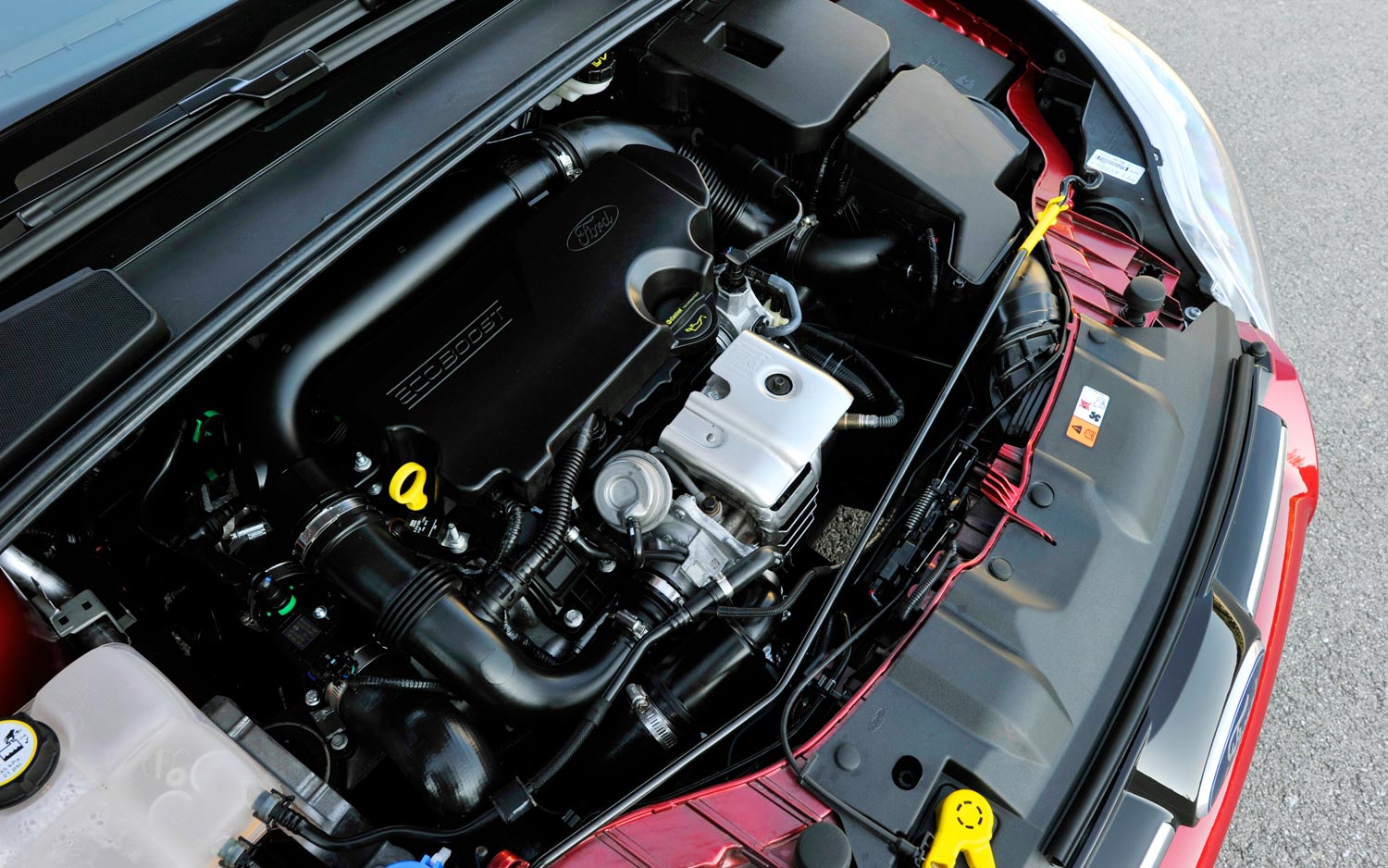В Ford заявили, что создали первый в мире трехцилиндровый турбодвигатель с системой деактивации одного из цилиндров. При незначительных нагрузках подача топливной смеси и работа клапанов может быть прекращена за 14 миллисекунд - в 20 раз быстрее моргания глаз, а затем, так же быстро возобновлена. По словам разработчиков технологии, переход между режимами будет таким плавным и быстрым, что водитель не заметит изменений. Добавление «двухцилиндрового» режима работы в трехцилиндровый двигатель позволить снизить расход топлива и выбросы СО2 на показатель до 6% без ущерба динамическим характеристикам автомобиля, заявили в Ford.
«Турботройку» EcoBoost 1.0 с системой деактивации цилиндра разработали специалисты Ford из исследовательских центров компании в трех странах: Германии, Великобритании и США. Помимо этого в проекте были задействованы инженеры Schaeffler Group. «Мы многократно протестировали систему в реальных условиях при моделировании разных сценариев чтобы добиться максимальной эффективности без ущерба комфорта во время вождения», - отметил Карстен Вебер, руководитель подразделения разработки силовых агрегатов Ford of Europe.
Однолитровый двигатель Ford EcoBoost появился в 2012 году на модели Focus. Пять лет подряд этот двигатель становился лучшим в своем классе по версии конкурса Engine of the Year. В настоящее время существуют три модификации «турботройки»: мощностью 100 л.с., 125 л.с. и 140 л.с. Они устанавливаются на европейские версии моделей Fiesta, EcoSport, B-MAX, Focus, C-MAX, Grand C?MAX, Tourneo и Transit Connect, Tourneo и Transit Courier, а также Mondeo. В прошлом году каждый пятый из проданных в Европе автомобилей Ford был укомплектован 1.0-литровым «ЭкоБустом».
FORD TO OFFER FUEL-SAVING CYLINDER DEACTIVATION TECH FOR 1.0 LITRE ECOBOOST; GLOBAL FIRST FOR A 3-CYLINDER ENGINE
- Ford to launch variable displacement for the multi-award-winning 1.0-litre EcoBoost engine using cylinder deactivation technology from early 2018
- Technology will be a global first on a three-cylinder engine; can stop or restart combustion in 14 milliseconds and improve CO2 and fuel efficiency by up to 6 per cent
- Ford engineers across Europe defy industry opinion by further enhancing three-cylinder engine's fuel efficiency with no compromise on performance or refinement
COLOGNE, Germany, Nov. 29, 2016 - Ford today announced that the multi-award-winning 1.0?litre EcoBoost petrol engine is to be offered with innovative cylinder deactivation technology for further reduced CO2 emissions and improved fuel efficiency.
Ford's compact and powerful 1.0-litre EcoBoost will in early 2018 become the first three-cylinder engine in the world to feature cylinder deactivation. The accomplishment is delivered through innovative engineering by Ford engineers across Europe, and defies industry opinion that a three-cylinder, variable capacity engine could not deliver the refinement needed for passenger car applications.
Cylinder deactivation will deliver reduced running costs for 1.0-litre EcoBoost customers by automatically stopping fuel delivery and valve operation for one of the engine's cylinders in conditions where full capacity is not needed, such as when coasting or cruising with light demand on the engine.
An example of the advanced engineering that enables Ford to deliver the power of choice to customers with fuel efficient petrol, diesel and electrified powertrains, the technology can disengage or re-engage one cylinder in 14 milliseconds - 20 times faster than the blink of an eye. Combined with advanced solutions to counteract vibrations, cylinder deactivation will be imperceptible to drivers in terms of operation and engine performance.
"Ford has pushed back the boundaries of powertrain engineering once again to further improve the acclaimed 1.0-litre EcoBoost engine, and prove that there is still untapped potential for even the best internal combustion engines to deliver better fuel efficiency for customers," said Bob Fascetti, vice president, Global Powertrain Engineering, Ford Motor Company.
Making the best even better
The cylinder deactivation system developed by Ford engineers in Aachen and Cologne in Germany, Dagenham and Dunton in the U.K, and Dearborn in the U.S., in collaboration with Ford's engineering partners at the Schaeffler Group, improves fuel efficiency and CO2 emissions by reducing friction and pumping demand inside the engine.
Simple in concept but featuring advanced engineering that enables it to operate at engine speeds of up to 4,500 rpm - when valves are each opening and closing almost 40 times per second - the system uses engine oil pressure to activate a special valve rocker and interrupt the connection between the camshaft and the valves of cylinder No. 1.
Sophisticated software determines the optimum moment to deactivate the cylinder based on factors including speed, throttle position and engine load. A new single-piece camshaft module - similar to the design debuted earlier this year for the all-new Ford EcoBlue diesel engine - frees space within the cylinder head for new oil channels and valve-switching componentry.
"With the variable capacity delivered by cylinder deactivation, drivers get the power and performance of the whole engine when they need it, and the enhanced fuel efficiency of a smaller engine when they don't," said Denis Gorman, powertrain engineer, Ford of Europe. "Our research shows that in most driving scenarios the system will be active for just a few seconds at a time, making fast and seamless operation crucial, and has the potential to improve fuel efficiency by up to 6 per cent."
Ford's single-cylinder deactivation design reduces complexity to make volume production achievable, but also presented significant challenges in maintaining the 1.0-litre EcoBoost engine's acclaimed refinement - delivered using innovations including an offset crankshaft configuration and deliberately "unbalanced" flywheel and pulley that counteract vibration.
A new dual-mass flywheel and a vibration-damping clutch disc help neutralise engine oscillations when running on two cylinders, especially at lower rpm, and enable a wider operating range. Intake and exhaust valves are closed when the system is active, trapping gasses to provide a spring effect that helps balance forces across the three cylinders for refinement, and also retain temperatures inside the cylinder that maintain fuel efficiency when reactivated.
New engine mounts, drive shafts and suspension bushes also will be specially tuned for refinement. The 1.0-litre EcoBoost will feature enhanced durability to cope with the different loading forces resulting from cylinder deactivation, including a new camshaft chain, and valve rockers formed using advanced metal injection moulding.
"Cylinder deactivation adjusts the effective engine capacity to maximise fuel efficiency, and to deliver the greatest benefit to customers, needs to be triggered in as many driving scenarios as possible," said Carsten Weber, manager, Powertrain Research & Advanced Engineering, Ford of Europe. "We intensively tested the system in real world conditions using a range of deactivation strategies to develop a system that maximises the fuel efficiency without compromising driving comfort."
Game-changing 1.0-litre EcoBoost
Ford's 1.0-litre EcoBoost engine was launched in the Ford Focus in 2012, and uses Ford EcoBoost technologies including high-pressure direct fuel injection, Twin-independent Variable Cam Timing and turbocharging to deliver optimised fuel efficiency alongside the power and performance of a naturally aspirated 1.6?litre engine.
The 1.0?litre EcoBoost was earlier this year voted best in class at the International Engine of the Year Awards for the fifth year in a row. In 2014, the 1.0-litre EcoBoost became the first engine to be named overall International Engine of the Year for a third time in a row, and also was in 2012 named "Best New Engine."
The compact engine - with a block small enough to fit into an aeroplane's overhead locker - is available with 100 PS, 125 PS and 140 PS - delivering a greater power-per-litre ratio than a Bugatti Veyron supercar.
Eleven Ford models, including Fiesta, EcoSport, B-MAX, Focus, C-MAX, Grand C?MAX, Tourneo and Transit Connect, Tourneo and Transit Courier, and Mondeo are available in Europe with the three-cylinder engine. One in five all-new Ford vehicles sold in Europe in last year were equipped with the 1.0-ltre EcoBoost, including almost two in five Fiestas.






Жируют гады!
давно пора переходить на одноцилиндровые или воще безцилиндровые моторы!
на одной турбине ездить скоро будем.